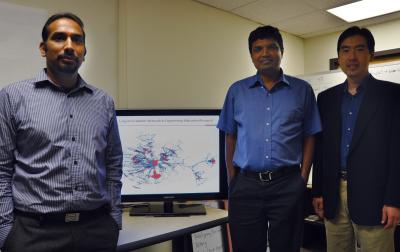SCIENCE
Knowledge mining resource accelerates science, technology education, research
Interdisciplinary collaborations bring vitality and success to the nation's research enterprise. Such interactions among disciplines also provide robust, real-life experiences for university students.
"If only HP knew what HP knows, we would be three times more productive." This quote by Lew Platt, the former CEO of HP, motivated a pair of researchers from the College of Engineering and the Pamplin College of Business to ask "How can we know what Virginia Tech knows and how can this knowledge enhance future research and education?"

With funding from Virginia Tech's strategic Institute for Critical Technology and Applied Science, which is interested enhancing research and education at the university, Aditya Johri, assistant professor of engineering education, and G. Alan Wang, assistant professor of business information technology, created Virginia Tech Knowledge Networks (VTKN) – and have gone on to partner in two multi-million dollar national projects as a result.
"VTKN is a repository of more than 5,000 publications by the College of Engineering faculty, which allowed us to test ideas and discover different kinds of interaction patterns across departments," said Johri. The technical term for the process is data mining and data visualization or, in this context, knowledge mining and authorship network visualizations. For instance, the collaborative patterns show that centers bring together researchers from different disciplines and interaction patterns of large centers are indistinguishable from those of many disciplinary departments.
"This prompts us to question the traditional disciplinary structure of colleges and universities at a time when interdisciplinary collaboration is becoming a norm and a necessity for addressing the grand challenges of the 21st century," said Johri.
In 2009, Johri and Wang partnered with researchers at Purdue University on the National Science Foundation (NSF)-funded project, Interactive Knowledge Networks in Engineering Education Research (iKNEER at ikneer.org). That network now contains more than 25,000 documents related to engineering education. "Users can dynamically interact with the information to understand the evolution and state of the field," said Johri.
Community memory is needed to allow faculty members to build on prior work. Enter iKNEER – a community memory capable of drawing knowledge to a problem faster than the firing of a human synapse. IKNEER allows someone who is not an expert in data mining to make sense of massive amounts of data through intuitive and user-friendly interfaces.
"This system is particularly useful for newcomers to the discipline, such as graduate students in the newly formed Departments of Engineering Education, as it provides a comprehensive and systematic understanding of the formation and growth of the field," said Johri. "For senior researchers it reveals prospective and potential research collaborations – particularly those across topics – that might lead to novel outcomes."
Meanwhile, in 2010, the Discovery Analytics Center (dac.cs.vt.edu) was launched at Virginia Tech with support from the Institute for Critical Technology and Applied Science. Directed by Naren Ramakrishnan, professor of computer science in the College of Engineering, the center brings together researchers from computer science, statistics, mathematics, and electrical and computer engineering to tackle knowledge discovery problems in such areas of national interest as intelligence analysis, sustainability, neuroscience, and systems biology.
Projects include quantifying multiple environmental impacts of a product across its entire life cycle; helping intelligence analysts by piecing together a story between seemingly disconnected information; connecting information embedded in patients' records; and, through collaboration with Johri and Wang, developing new data mining and visualization tools for characterizing the portfolio of projects conducted through the NSF's Transforming Undergraduate Education in Science, Technology, Engineering, and Mathematics program.
In September 2011, the NSF funded a new project to create a resource for educators of science, technology, engineering, and math (STEM) – fields where U.S. students lag the rest of the world. Johri and Wang, joined by Ramakrisnhan, are partnering once again with their Purdue colleagues, plus with researchers at Stanford and Arizona State University. The researchers will create an interactive Web search and information visualization platform called Deep Insights Anytime, Anywhere.
Funded by a $3 million, four-year grant, the project aims to help researchers and NSF program officers identify trends in publications and research funding, gaps in current research and funding, and potential collaborators in science, technology, engineering, and mathematics education.
"This is a Web-based knowledge-mining interactive visualization platform," said Krishna P. C. Madhavan, assistant professor of engineering education at Purdue and principal investigator for the project, who is working with co-principal investigators Niklas Elmqvist, an assistant professor of electrical and computer engineering, and Mihaela Vorvoreanu, an assistant professor of computer graphics technology, also at Purdue.
The Deep Insights system will enable researchers and officials to quickly determine who is working in specific areas, who their collaborators are, and to identify funding sources, program officers, research papers and findings. The system visualizes complex networks of funding and research collaborations with a map created anew for each search. The network map contains clickable nodes that yield further layers of information. "The interactive visualizations are designed to shed light on insights that may be typically hidden from a researcher or educator," Madhavan said.
"The Virginia Tech team will work closely with the other universities' researchers to understand the needs of the NSF undergraduate education community and use their needs to drive the design of data mining algorithms," said Johri. "This project will leverage the resources of the Discovery Analytics Center and the prior work by Johri and Wang as part of iKNEER and Virginia Tech Knowledge Networks."
